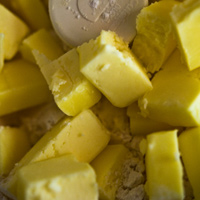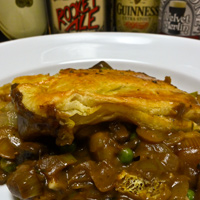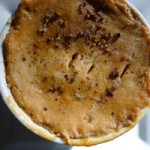Pot Pie Crust
 This Pot Pie Crust is a little different than the norm, using barley and oat flour alongside the all-purpose. Barley flour is very similar to pastry flour, very low in gluten and a soft protein. The oat flour gives the crust a tiny bit of chew to make up for the lower-gluten flour. Both flours add extra flavor and complexity to the standard all-purpose.
This Pot Pie Crust is a little different than the norm, using barley and oat flour alongside the all-purpose. Barley flour is very similar to pastry flour, very low in gluten and a soft protein. The oat flour gives the crust a tiny bit of chew to make up for the lower-gluten flour. Both flours add extra flavor and complexity to the standard all-purpose.
This dough can be used for many different culinary approaches. Pot Pie Crust was what is was originally designed to cover, but after some more experimentation I found it works well for an empanadas dough, to a Pie Crust (being pre-baked or filled and then baked) to a turnover crust. The possibilities with this Pot Pie Crust are endless, especially if you swap out the Irish Red Ale and try other flavor directions.
Note: This dough can be made a day in advance, with leftovers dough being frozen for a later creation.
Makes: enough crust for a 9-by-13 casserole pan or 12-14 individual 4-inch ramekins
Originally published in BeerAdvocate Magazine: Cuisine à la Bière | Mar 2012 | Issue #62
- 1 cup flour, barley
- 3/4 cup flour, all-purpose
- 1/4 cup flour, oat
- 1 teaspoon salt, kosher
- 1 teaspoon baking powder
- 1/2 cup butter, unsalted preferably European style with a high butter fat %
- 6 - 7 tablespoon Irish Red Ale, or other lower IBU style brew
- In the bowl of a food processor, add the barley, all-purpose and oat flour, along with the salt and baking powder. Pulse several times to mix the ingredients together. Add the cold butter to the bowl, and pulse a few times to cut the fat into the flour.

- Keep pulsing until the mixture has small, grain-size chunks of butter evenly distributed throughout the mixture. With the motor on pulse, slowly pour the ice-cold beer into the feed tube, mixing the ingredients into a dough. Be careful not to over-process the crust. Form the dough into two balls, seal in plastic wrap, and press down on each to create a disk. Place in the refrigerator for at least 30 minutes to re-chill the fat, preventing the crust from shrinking as it cooks.

- Take one dough ball and roll it out to a 1/4-inch-thick sheet on a lightly floured surface. If you don’t have a rolling pin, use a 22-ounce bottle (filled with cold brew), and dust it with flour. If making a large pot pie, roll out to a 9-by-13-inch rectangle. Lightly dust the surface of the dough with flour, and roll the dough onto the rolling pin, using the pin to transfer the dough to the filled casserole pan and un-roll onto the surface. Using the tip of a sharp paring knife, cut a series of holes in the crust in a decorative pattern. This will allow the steam to escape. If making individual pot pies, use a ramekin to press out circles of the rolled out dough to cover each ramekin. Again, cut some holes into the surface.

Other recipes that use this recipe:






